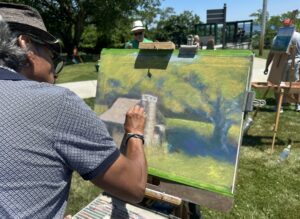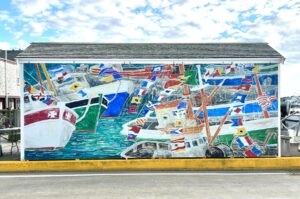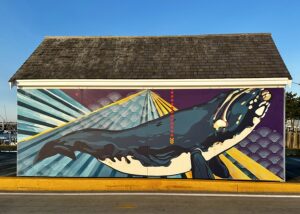Aparna Nancherla at Payomet
“Maybe she’s born with it — maybe she’s trapped in a societal prison of impossible beauty standards” goes stand-up comic Aparna Nancherla’s riff on that old Maybelline advertisement.

Nancherla will be bringing her clear eye and cutting wit to the Payomet Performing Arts Center (29 Old Dewline Road, North Truro) on Friday, July 12 at 7 p.m.
Nancherla has been featured on comedy programs including HBO Max’s Search Party, Netflix’s BoJack Horseman, and Peacock’s Lopez vs Lopez, and her late-night appearances include Stephen Colbert, Seth Meyers, and James Corden. In 2017, she was listed by Rolling Stone as “one of the 50 funniest people right now,” and her book Unreliable Narrator: Me, Myself, and Impostor Syndrome — an essay collection about self-doubt and self-examination — was listed by the New Yorker as one of the best books of 2023. She is also the host of The Introvert’s Survival Guide, a comedic self-help podcast in which she guides listeners through all sorts of everyday nightmares: first dates, networking events, and interminable small talk.
Many of Nancherla’s stand-up sets demonstrate her talent as an outspoken yet pithy commentator on mental health issues. “I like to do my depression on the weekends,” she says in her 2018 Netflix special. “Anxiety is on the weekdays. It’s like split custody.”
Tickets are $38 at payomet.org. —Paul Sullivan
‘Confessions of a Prairie Bitch’ at Red Room
Fifty years after the NBC family drama series Little House on the Prairie premiered in 1974, Nellie Oleson endures as one of the all-time TV characters who audiences loved to hate. With her haughty demeanor and manipulative scheming — not to mention her signature blond ringlets — the spoiled and spiteful Nellie terrorized the town of Walnut Grove while delighting viewers, especially whenever she received her rightful comeuppance.

Actor, comedian, and activist Alison Arngrim, who originated the role and will be performing her solo show “Confessions of a Prairie Bitch” at Red Room in Provincetown this weekend, isn’t surprised that so many viewers fondly recall Nellie’s bratty antics after all this time.
“For many people, Nellie was their first diva, their first queen bitch,” she says. “We all have a Nellie at our school, or our job, or in our house. Or possibly we are the Nellie! You know who you are.” And she thinks she understands why queer audiences still respond so strongly to the character. “I know with that insane wig and those over-the-top dresses, I certainly felt like I was in drag for seven years.”
Arngrim first performed the show, which is described as a mix of storytelling, standup, and multimedia, in New York City in 2002. It later served as the basis of a book, Confessions of a Prairie Bitch: How I Survived Nellie Oleson and Learned to Love Being Hated, published in 2010. Along with her acting and standup career, Arngrim has worked extensively with AIDS education and support organizations and is currently president of the National Association to Protect Children, a child welfare advocacy organization.
For all her other activities, Arngrim says that connecting with fans of Little House on the Prairie remains a central focus, particularly as the show celebrates its 50th anniversary this year. “It’s such an emotional show, filled with things people can truly identify with,” she says. “I’m so proud that something I did as a snotty teenager has brought so much happiness to so many.”
“Confessions of a Prairie Bitch” runs nightly from Friday, July 12 to Sunday, July 14 at Red Room (258 Commercial St., Provincetown). Tickets are $35 ($45 for V.I.P. seating) at redroom.club. —John D’Addario
Marnie Crawford Samuelson Captures ‘an Outer Cape Village’
Provincetown’s magic, many say, is fading. Longtime townies who built lives here before the 21st century describe a stark transformation: a gritty, affordable bohemia evolved into a condo-ized resort town.

Marnie Crawford Samuelson is among those who reminisce about the days before second-home owners and day-trippers largely supplanted the artistic community that once defined this end of the world. Her series of photographs, “An Outer Cape Village,” currently on display at the Provincetown Art Association and Museum (460 Commercial St.), captures Provincetown’s former self, the people who defined it, and what remains. Some of the photographs originally appeared in the Provincetown Independent.
“People feel a loss of things that used to be here, the community that was here, grittiness that was here,” says Samuelson. “I don’t think it’s nostalgia, but I think it’s a profound sense of sorrow.”
Samuelson began photographing on the Outer Cape in the mid-1980s. The black-and-white film photographs she took during that time capture life as it was then (scenes of friends caring for loved ones with AIDS) and as it still is (a photo of a group of guys hanging outside the A-House at night). “I look for anchor points that are really authentic experiences,” says Samuelson. Her recent work shifts to documentary portraits of Outer Cape residents immersed in the places where they live, work, and play, as in her photographs of Mike Rego, a Truro lobsterman, sitting on a lobster trap holding a buoy, and Dana Franchitto, a pianist and substitute teacher, clutching his surfboard after a long session at Lecount Hollow Beach.
Samuelson’s portraits are immersive, drawing viewers into the natural settings she captures along with her subjects and their props. Even when her subjects stand alone in the frame, there’s a palpable connection between them, embodying what makes life here special: the people.
“An Outer Cape Village” is on view until July 21. See paam.org for information. —Elias Duncan
‘Painting on the Hill’ at the Pilgrim Monument
At the first “Painting on the Hill” session on the lawn at the Pilgrim Monument and Provincetown Museum last week, everyone was an artist for four hours. Class members stood in the afternoon sun, scattered across the top of High Pole Hill. With paintbrushes in hand and easels in front of them, they surveyed the grass and the harbor.

Artist and instructor Thomas Acone welcomed beginner and experienced painters and began the class with a walk on the lawn, encouraging students to observe the shapes, shadows, and shades of the setting.
“He showed us how to pick out a site,” said Veda Henderson, a participant. “He has you just focus on that one little piece of the landscape.” This was Henderson’s first time painting in decades. The last time had been in college during a mandatory art class. “The professor told me that he would give me a ‘C’ if I promised to never paint again,” she laughed.
Acone noted how many of the painters went from carefully sketching their scenes to making confident brushstrokes over the course of the class. “I think colors do something to the brain,” he said, “where it just settles people.” His approach to painting is to simply create: there’s no perfect way to do it.

As the class approached its end, Henderson worried that her leaves weren’t finished and there was no boat in the water in her painting. Acone reassured her that she didn’t have to rush; she could take the paint and brushes home.
The class costs $139 per person and includes art supplies. Classes will be held every Tuesday from 10:30 a.m to 2 p.m until Aug. 27. See pilgrim-monument.org for information. —Kiran Johnson
A Concert That’s Exactly What We Need
In May 2020, New York City was eerily quiet, save for the wailing of ambulances and a few minutes of defiant ruckus every night at seven as people banged pots and pans from their windows to show gratitude to health-care workers. In Brooklyn Heights, musician Peter Kendall Clark was also making noise, singing on his stoop for his neighbors.

“I got more media attention for that than anything in my entire career,” he says. “The New York Post called me the ‘Brownstone Baritone.’ ” But it wasn’t the attention that kept him going — it was the feeling that his singing was a “balm” for listeners.
There’s something healing about being in the presence of acoustic music and feeling the vibrations, says Clark: “It’s like somebody touching your head.” While Clark plays the violin and viola, he’s a singer, he says, because he loves songs: music with words.
Brahms’s “Gestillte Sehnsucht” (“Stilled Longing”) is one of the songs he loves most. A sweeping romantic piece set to a poem by Friedrich Rückert, it is heavy with grief and yearning. The piece inspired the program for “Still Longing,” his upcoming concert with cellist Tyler Michael James and pianist Markus Kaitila at the Chapel of Saint James the Fisherman in Wellfleet (2317 Route 6) on Wednesday, July 17 at 5:30 pm. The song is usually sung by a mezzo-soprano, says Clark, and accompanied by piano and viola. For the concert, it will feature Clark’s rich baritone and the deeper voice of the cello.
After one performance of the Brahms, he says, “Somebody said, ‘Oh, I just lost a friend, and this was exactly what I needed.’ ” The three musicians have a forthcoming album of the same name.
The program features music by Tchaikovsky, Strauss, Viardot, and Brahms. It also includes music by Leonard Bernstein: a solo from his 1977 song cycle Songfest. Clark first heard the piece at Bernstein’s 78th birthday gala at Tanglewood in 1996 and fell in love with it.
Bernstein isn’t a Romantic era composer. But the theme of the concert is meant to defy the separating categories of time. The music handles with beauty and care feelings of loss and pain that are otherwise difficult to express. “More and more in life,” says Clark, “we need music like this.”
A suggested donation of $20 will support the chapel’s Cape Outreach Program. See stjameschapelwellfleet.org for information. —Dorothea Samaha
New Public Art in Provincetown
Three new projects spearheaded by the Provincetown Public Art Foundation this summer aim to fulfill the nonprofit organization’s mission “to tell the story of Provincetown’s past, present, and future with public art.”

The largest project involves seven artists who created murals to display on the artist trap sheds along MacMillan Wharf. The town-owned sheds are operated by Pier Manager Jamie Demetriou and are rented to artists to display and sell their work.
Felipe Ortiz, one of the muralists, rented a shed last summer and proposed the idea to Samuel Tager, executive director of the foundation. Tager was taken with the concept.
“We’re really focused on site cultivation and creating opportunities for as many artists as we can,” says Tager, who collaborated with Demetriou and the artists. Tager hopes that this will become a tradition featuring seven new artists each summer.
Three of the artists — Ortiz, Jackie Reeves, and Sophy Tuttle — were included in the 2023 exhibition “Walls That Connect: The Cape Cod Mural Project” at the Cape Cod Museum of Art, which Tager curated. They are joined by Boston-based Silvia López Chavez and Outer Cape artists William Evaul, Vicky Tomayko, and Mark Adams.

Artists were given aluminum panels of about 7 by 20 feet and free rein for their designs. Many of the images feature natural imagery, like Tuttle’s piece inspired by a recent flamingo sighting on Cape Cod and Chavez’s painting of a right whale. Evaul reproduced one of his white line prints of the harbor, dramatically increasing its scale. Tomayko also worked with a printed reproduction of an older work, altered in her studio by screen printing and painting on top of it.
The Provincetown Recreation Dept. provided space at Motta Field where the artists could paint their panels. For two other projects installed this summer, town residents offered space on private property. A mural of Provincetown Harbor by Joseph Wardwell was recently installed on a property owned by the Yingling family on the corner of Court and Commercial streets. At the other end of town, The Three Bureaucrats, a wind-driven sculpture by George Greenamyer, sits next to Angel Foods on the property of the Bryant family. Recently named the Bryant Cook Saltworks Art Site, the location pays homage to George Bryant, who built a structure (which he quickly abandoned) for producing salt there in the 1970s. —Abraham Storer
Surrealist Film Shorts at PAAM
Two short films made in the first half of the 20th century that have inspired generations of visual artists will be screened in the first installment of a two-part series at the Provincetown Art Association and Museum on Wednesday, July 17 at 6 p.m.

A collaboration between artist Salvador Dali and director Luis Buñuel, Un Chien Andalou (1929), is regarded as a seminal work in the history of Surrealist art. With its indelibly startling stream-of-consciousness imagery, the film still has the power to shock nearly a century after its creation. Maya Deren’s Meshes of the Afternoon (1943) is quieter in its presentation but no less radical with its elliptical narrative and experimental technique that depicts the interior, subjective experience of an individual.
The screenings are part of the Provincetown Art Gallery Association’s programming for the summer-long Forum 24 series, which celebrates the 75th anniversary of a 1949 presentation of modern art in Provincetown featuring several prominent midcentury artists. There will be a second installment of the series featuring Alain Resnais’s Le chant du Styrène (1958) and an excerpt from Matthew Barney’s Cremaster 3 (2002) on Wednesday, Aug. 21.

The series is curated by Howard Karren, who will provide introductory context and discuss the films with the audience after each screening. “I chose classic surrealist shorts for the first screening, reflecting the concerns of the original Forum 49, when Abstract Expressionists were trying to take art as far from realism as it could go,” says Karren. “And I chose more modern avant-garde films for the August screening, as they might be more salient to artists today.”
Screenings are free with museum admission ($15). See provincetownartgalleryassociation.org for more information. —John D’Addario



